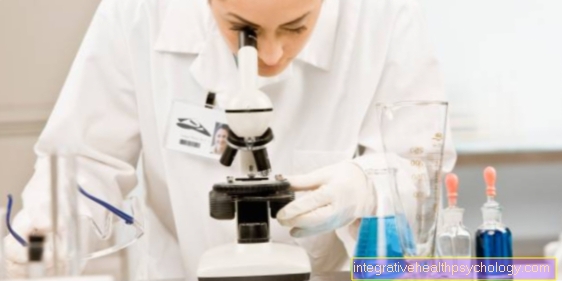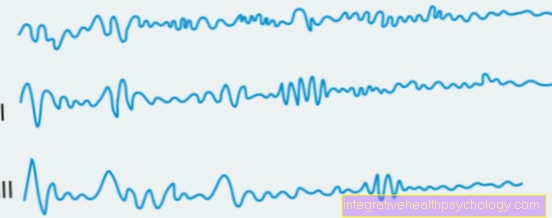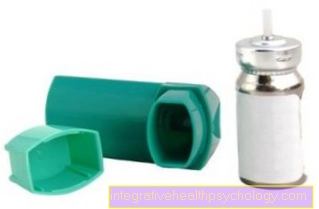Liver biopsy
What is a liver biopsy?
A liver biopsy is the removal of a sample of tissue from the liver. Liver puncture is also used synonymously for a liver biopsy. It is carried out to determine the cause of unclear liver diseases or to carry out follow-up checks for chronic liver diseases.

Indications for a liver biopsy
The indication for a liver biopsy is made by the attending physician. He will carefully weigh the benefits of a liver biopsy against the possible risks.
Possible indications for a liver biopsy can be:
- the clarification of liver values that deviate from the norm (increased liver values)
- chronic liver disease
- inflammatory liver disease
- suspected cancer
- an unexplained jaundice
- Metabolic diseases
- a fatty liver.
Is a Liver Biopsy Painful?
A liver biopsy is not very painful due to the local anesthesia of the skin and muscles in the area of the puncture site. Nevertheless, there can sometimes be slight pain during the procedure. These can radiate into the shoulder. If pain occurs, pain relievers can of course be administered.
What pain does one have after a liver biopsy?
A liver biopsy may result in mild and dull pain. This can also radiate into the shoulder if necessary. Pain relievers such as acetaminophen can be taken if needed. Aspirin and ibuprofen should be avoided after a liver biopsy, as they have an inhibitory effect on blood clotting. If the pain is very severe, you should consult a doctor immediately to rule out possible complications.
Preparation before a liver biopsy
Anticoagulant drugs should be partially discontinued before a liver biopsy. The anticoagulant drugs include Marcumar, new oral anticoagulants (NOAC), ASA, clopidogrel, but also some pain relievers (NSAIDs) such as ibuprofen. The distance at which the medication must be discontinued and which you can continue to take should be discussed with the attending physician. Even after the liver biopsy, the discontinued medication must not be taken for a few days in order to reduce the risk of bleeding.
Before a liver biopsy, there will be an informative discussion in which you will be informed about the procedure, possible risks and, if necessary, alternative procedures. On this day, blood is usually drawn again to determine the current blood values. The blood count and the current coagulation values are particularly important here.
On the day of the liver biopsy, you should be on an empty stomach. This means that the last meal can be taken on the evening before the liver biopsy. Clear liquids such as water or tea can usually be drunk in moderation up to 4 hours before the biopsy. Here, too, it is advisable to consult the attending physician.
The medications that you normally take in the morning and at noon on the day of the liver biopsy should usually only be taken after the liver biopsy. Your treating doctor will also inform you about this.
How does a liver biopsy work?
The liver biopsy takes place in the supine position. You may be given a sedative before the biopsy. The liver is located under the right costal arch. This area is sufficiently disinfected and the skin, the subcutaneous fat and the muscles are sufficiently anesthetized with a local anesthetic so that you only feel little of the liver biopsy. The liver biopsy is performed with the aid of an ultrasound device. You will be asked to hold your breath so the liver continues to slide down. In the meantime, a hollow needle removes a small cylinder of tissue from the liver. This only takes about 2-3 seconds. You can then continue to breathe normally.
A sterile plaster bandage is then applied and you have to lie on a sandbag on the right side for a few hours to compress the puncture site. Your pulse and blood pressure will be checked at regular intervals. The blood count will also be checked again. If everything went straightforward, you can start eating again soon after the liver biopsy.
Evaluation of the tissue sample
The tissue cylinder is analyzed and evaluated by a pathologist under a microscope. Often times, the sample is processed with special staining techniques and immunological test procedures so that an even more precise result can be obtained. The result is usually available after 3-5 days. Your doctor treating you will then discuss the result with you.
How long does it take to get the results?
It usually takes 3-5 days for the pathologist to analyze the tissue sample. With special examination techniques, the result may take a little longer.
What are the risks of a liver biopsy?
A liver biopsy is a small and generally very low-risk procedure.
Since the liver is a very well supplied organ, it can lead to bleeding and haematomas. Surgical hemostasis or the administration of foreign blood (blood transfusions) are very rarely necessary.
In rare cases, other organs, such as the lungs, intestines or gallbladder, can be injured. Infections in the area of the skin, chest wall or peritoneum (peritonitis) are possible in rare cases.
If the tissue cylinder obtained is not sufficient, it may be necessary to perform another liver biopsy.
A liver biopsy should not be performed in the case of large amounts of ascites, severe blood clotting disorders, severe build-up of bile in the liver (cholestasis), inflammation of the biliary tract (cholangitis) in order to minimize the possible risks.
How long does a liver biopsy take?
The liver biopsy itself, i.e. the removal of the tissue cylinder itself, only takes a few seconds. With preparation and follow-up, however, you should plan around 30 minutes for a liver biopsy.
What does a liver biopsy cost?
A liver biopsy is taken over by the health insurance company for legally insured persons with an indication by a doctor. Without a justifying indication, a doctor will not perform a liver biopsy.
If the liver biopsy is billed according to the fee schedule for doctors (GOÄ), as is the case, for example, with privately insured persons, it is billed at the simple rate of 14.57 euros. Billing based on 2 to 3 times the rate is also possible. Added to this are the costs for the material used and the tissue examination.
Are there alternatives?
Only a liver biopsy can provide a reliable diagnosis, since this is a tissue sample. There are alternative methods of obtaining a tissue sample. Using ultrasound, MRI (please refer: MRI of the liver) or CT can provide clues for an underlying disease.
How long are you on sick leave after a liver biopsy?
How long you are on sick leave depends on your professional activity and the course after the procedure. Intense physical activity should be avoided for at least a week. If the pain or complications are severe, a sick leave can be extended.
As a rule, you are written off sick 3-5 days after a liver biopsy if the course is uncomplicated.
Can a liver biopsy be performed on an outpatient basis?
A liver biopsy is usually not done on an outpatient basis. It is important to monitor the patient 24 hours after a liver biopsy, to check the pulse and blood pressure regularly and to check the blood values again. In addition, bed rest should be maintained for 6-8 hours and the puncture site should be compressed by lying on the right side on a sandbag in order to reduce the risk of secondary bleeding.
How long can I not do sports?
After a liver biopsy, usual activities can be carried out. However, intensive physical activity or travel to countries without modern health facilities should be avoided for at least 7 days. If a liver biopsy has developed complications, it may be necessary to pause exercise until full recovery is achieved.





























